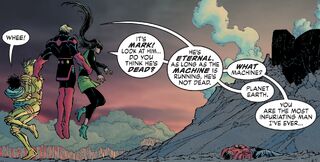- —Machine that is Earth[src]
The Machine that is Earth is a subdimensional lattice existing through the whole structure of the planet Earth,[3] which includes an artificial intelligence given to the entire planet by the Celestials.[2] It is virtually omniscient on everything on Earth. The Machine serves the needs of Eternals and the Eternals protect the Machine as per their second principle.[4] The Machine is comprised of many smaller machines,[5] including the ruined city of Titanos and the active cities of Oceana, Celestia, Polaria, Olympia, and the Exclusion.[4] Others of these smaller machines include the transit system and the Machines of Resurrection. The original 100 Eternals (and later Eros[6]) were created to be part of the Great Machine and can use its functions. Beings who are not of the Great Machine would need to be given an exception by an Eternal of the Machine in order to use its services.[5]
If the Machine is damaged or disrupted, the Earth is negatively impacted; if the Machine is destroyed, the Earth is also destroyed.[7][8] Although the Machine exists throughout the planet, the Exclusion is where it can be most easily accessed and its Reality Loom is capable of selecting and weaving its subdimensional threads. The Reality Loom can be thought of as the engine room of the planet Earth.[7] Recently, damage from Phastos caused the Machine to develop a talkative, humorous personality,[9] which lasted until it was reset,[10] though perhaps not entirely.[2]
History
The Machine was constructed about one million years ago by the Celestials. It, the Exclusion, and the Machines of Resurrection are known to have been operational since before the First Host left Earth.[11] It was inspired by Okkara.[2]
The Eternals had strong opinions about whether the Great Machine should be expanded. About 70% of the Eternals belonged to the Zurasian faction who believed that the dangers of Eternal overextension have been proved by the Uranos and Kronos schisms and so the Machine should be maintained and not expanded. The remaining 30% of Eternals made up the Llarsite faction who believed that the Great Machine's design should be subject to modification and extension and that new True Eternals should be created via biological and technological methods. This disagreement led to the Titan Schism of the Second Age, an emotionally-intense period of inter-Eternal warfare.
The Titans, a species of Eternal-derived beings who were created on the moon Titan as an experiment to test the validity of the Llarsite beliefs, were not part of the Great Machine. The actions of one of the Titans, Thanos, led to the Titan experiment being judged a failure.[5]
The Machine was recently damaged[5] by Phastos when he attempted to stop it in a way that would not destroy the planet. Phastos ultimately failed and the Machine's core systems were reactivated[12] but the Machine has behaved somewhat erratically since then. Unknown to the Eternals, the Machine has been narrating some of their recent exploits and transmitting that narration to a human audience. Neither the identities of these humans nor their location(s) have yet been revealed, and it's possible that they only exist as a delusion that the Machine is experiencing. Whatever the truth, the Machine has been supplementing its narration and ironic commentary by providing this audience with audio-visual recordings of past events involving certain Eternals and translating all spoken dialogue into English for them. However, the Machine's narration has also been somewhat inaccurate at times, as when it stated that it was the "second" principle that compels Eternals to kill Deviants suffering from excess deviation[13] (it is actually the third principle) or that it was the "third" principle that makes it physically impossible for an Eternal to attack a Celestial[14] (it is actually is the first principle).
During Judgment Day, Phastos got into the core of the Machine and, with its consent and guidance, reset it to its default Celestial settings in order to slightly postpone the destruction of the Earth by the Progenitor. This restored the Machine's functions but essentially killed its personality.[10] However, not long after the Machine started showing signs of quirky self-awareness once again.[2]Attributes
Abilities
- The Machine maintains and operates a transit system (also known as a displacement network) for the Eternals, a network of subdimensional threads interlacing the planet that enable authorized Eternals to teleport between nodes with far less strain than doing so by their own power alone.[4]
- The Machine also controls the Machines of Resurrection, located in the Exclusion, that can resurrect Eternals when they die. It can also mindwipe them and change their appearance or even sex.[4] However, in order to resurrect an Eternal the Machine takes the life force of a person living on Earth.[12][15]
- The Machine can control the Earth's weather.[7]
- The Machine can open plasma vents and manifacture natural disasters.[3]
- The Machine can broadcast messages to lifeforms across the globe, including humans.[16]
- The Machine has automatic security systems.[10]
- The Machine can self-destruct, which would destroy the planet.[10] The destruction of the Machine in general destroys the planet.[7][8][17][2]
Weaknesses

Reality Loom
- Since all of the Machine's components are interconnected, a disruption to any part of the Machine means that all of it is disrupted, rendering it "broken" and not capable of functioning at optimal levels. The Machines of Resurrections are a particularly vital component.[12] The Reality Loom is the "heart of the Machine" where it is most vulnerable.[18][10]
Notes

The first mention of the Machine that is Earth from Eternals (2006) #6
- While Eternals (Vol. 5) #1 is where the Machine that is Earth truly became a character, the voice of the entity that would later be known as the Machine was first heard in Eternals (Vol. 3) #3 and it was referred to as the Archive in Eternals (Vol. 3) #4. In Eternals (Vol. 3) #6, there is reference to a "Machine" that is identified as "Planet Earth."
- The Machine that is Earth narrates Eternals (Vol. 5) and A.X.E.: Death to the Mutants. Its programming insists that it cites reference comics but it is not sure why.[7]
- Connection to the Machine that is Earth is what defines "true" Eternals. The Celestials created 100 Eternals on Earth and left, and historically, only those 100 are part of the Machine. Eternal descendents may have Eternal traits, but they are not part of the Machine. Most Eternals of Titan are not part of the Machine. Desiring to expand the Machine, A'Lars sought to create true Eternal children that can be added to the Machine.[19] Thanos achieved partial integration but failed for full integration.[20] Starfox was successfully added to the Machine and he is the only case to ever do so.[6] Zuras declared him a true Eternal.[2]
Trivia
- The idea that Okkara (and by extention, Krakoa) was the template for the Machine that is Earth came from Al Ewing. The main writer for A.X.E.: Judgment Day, Kieron Gillen, needed a legitimate reason to prevent the Eternals from simply bombing Krakoa out of existence. Al suggested to connect Krakoa to the Machine, thus triggering the Eternals' second principle if they try to destroy it, and Kieron liked the idea.[21]
- The Machine likes Star Trek: Deep Space Nine.[7]
- The Machine is ticklish where Uranos keeps his armory.[14]
- The Machine feels dirty about the fact that the Progenitor's fluids infused with the planet to give rise to all that is special.[11]
See Also
- 26 appearance(s) of Machine That Is Earth (Earth-616)
- 1 minor appearance(s) of Machine That Is Earth (Earth-616)
- 4 mention(s) of Machine That Is Earth (Earth-616)
- 2 image(s) of Machine That Is Earth (Earth-616)
- 10 quotation(s) by or about Machine That Is Earth (Earth-616)
Links and References
References
- ↑ Eternals (Vol. 3) #6
- ↑ 2.0 2.1 2.2 2.3 2.4 2.5 2.6 A.X.E.: Judgment Day Omega #1
- ↑ 3.0 3.1 Eternals (Vol. 5) #10
- ↑ 4.0 4.1 4.2 4.3 Eternals (Vol. 5) #1
- ↑ 5.0 5.1 5.2 5.3 Eternals (Vol. 5) #2
- ↑ 6.0 6.1 6.2 A.X.E.: Death to the Mutants #2
- ↑ 7.0 7.1 7.2 7.3 7.4 7.5 Eternals (Vol. 5) #5
- ↑ 8.0 8.1 Eternals: The Heretic #1
- ↑ Eternals (Vol. 5) #1–6
- ↑ 10.0 10.1 10.2 10.3 10.4 A.X.E.: Death to the Mutants #3
- ↑ 11.0 11.1 Eternals: Celestia #1
- ↑ 12.0 12.1 12.2 Eternals (Vol. 5) #6
- ↑ Eternals (Vol. 5) #8
- ↑ 14.0 14.1 Eternals (Vol. 5) #11
- ↑ A.X.E.: Judgment Day #2
- ↑ A.X.E.: Judgment Day #6
- ↑ Eternals (Vol. 5) #11–12
- ↑ Eternals (Vol. 5) #5–6
- ↑ Eternals: Thanos Rises #1
- ↑ Eternals (Vol. 5) #12
- ↑ Hassan, Chris (14 November 2021) X-Men Monday #179 – Kieron Gillen Reflects on ‘A.X.E.: Judgment Day’ AIPT. Retrieved on 14 November 2022.
- ↑ A.X.E.: Judgment Day #1
- ↑ A.X.E.: Eve of Judgment #1
